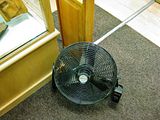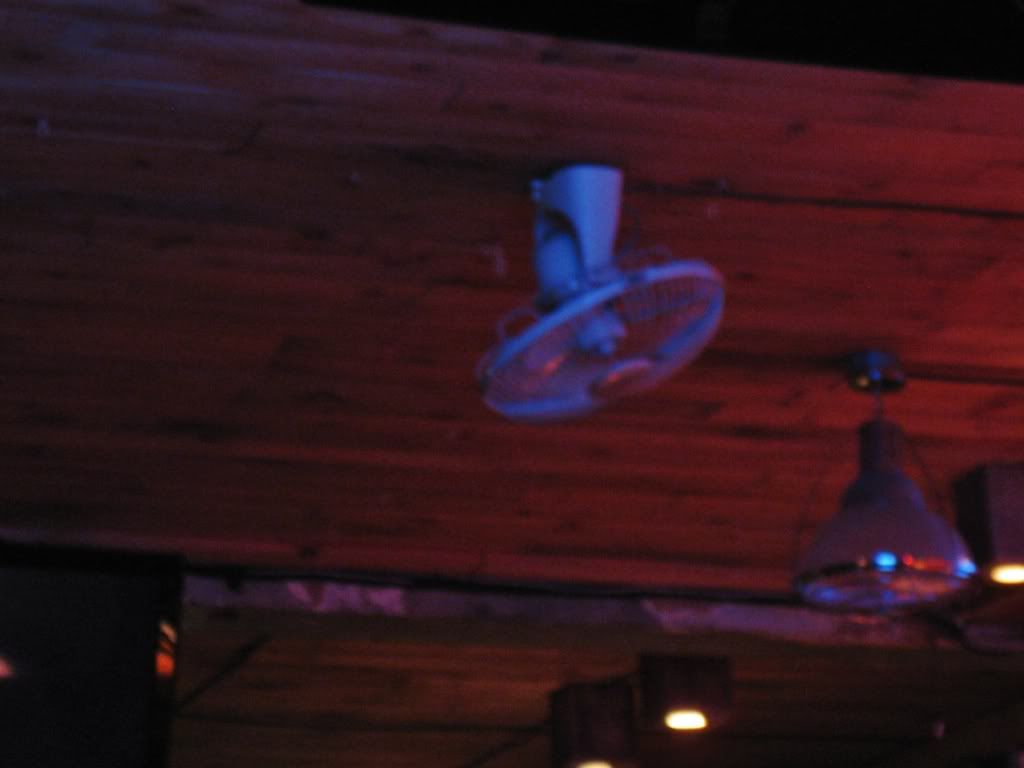|
|
Post by Jean Lemieux on Sept 10, 2012 21:03:17 GMT -5
It boggles my mind as to how air can even pass those grilles.. It's so funny how everyone focuses only on the finger proof grills and are surprised about them. They were the norm in the 1980s-1990s. They let air pass through very easily. |
|
Dob
Full Member
   Vornado Collector
Vornado Collector
Posts: 336
|
Post by Dob on Sept 11, 2012 12:38:34 GMT -5
It boggles my mind as to how air can even pass those grilles.. It's so funny how everyone focuses only on the finger proof grills and are surprised about them. They were the norm in the 1980s-1990s. They let air pass through very easily. I wouldn't say as easy compared to a fan with less restrictive grilles. There is more wires than there is gaps. |
|
|
|
Post by Jean Lemieux on Sept 11, 2012 18:54:11 GMT -5
It's so funny how everyone focuses only on the finger proof grills and are surprised about them. They were the norm in the 1980s-1990s. They let air pass through very easily. I wouldn't say as easy compared to a fan with less restrictive grilles. There is more wires than there is gaps. Oh yes of course it have less chances to let air passes but theses 1980s-1990s grills still let a lot of air pass through, more than some of you seem to think. The difference is not too noticeable. It's really more the blade pitch that decides if the fan have a good air flow or not. |
|
Austin
Full Member
   Iron Pony champion
Iron Pony champion
Posts: 363
|
Post by Austin on Sept 11, 2012 21:04:19 GMT -5
It boggles my mind as to how air can even pass those grilles.. They were the norm in the 1980s-1990s. They let air pass through very easily. Yeah, maybe in Canada but they were seldom seen here in the US. Yes, blade pitch is a factor in good airflow but you also have to take in other factors like the power of the motor and the guard. Having a good pitch and powerful motor will create a lot of air flow but having a very restrictive guard can ruin that by restricting the amount of air the fan can move. Thats why wire guards were better, they didnt hurt the performance of the fan. |
|
|
|
Post by Jean Lemieux on Sept 13, 2012 17:21:23 GMT -5
They were the norm in the 1980s-1990s. They let air pass through very easily. Yeah, maybe in Canada but they were seldom seen here in the US. Yes, blade pitch is a factor in good airflow but you also have to take in other factors like the power of the motor and the guard. Having a good pitch and powerful motor will create a lot of air flow but having a very restrictive guard can ruin that by restricting the amount of air the fan can move. Thats why wire guards were better, they didnt hurt the performance of the fan. The term ruining is a too strong. I've never seen them as ruining the air flow. The air is not really trapped. If it cannot pass by the front, it will pass on the sides or somewhere else. That's why theses grills create a more diffuse air flow rather than a jet-like air flow like the spaced grills does. That's why with a finger proof grill fan, air can be felt from a little everywhere and not just from the front which is kind of cool. What I don't like as much with finger proof grills is that they hide more the blades and I love to see well the blade set on a fan. On the other side the problem with spaced grills, especially the ones with flexible spokes is that the fans using theses grills often end up with scratched blades if not chipped because objects or fingers can be inserted too easily. |
|
|
|
Post by Jean Lemieux on Sept 13, 2012 17:24:31 GMT -5
Some high velocity fans in the exercise room at my college. Mid to late 2000s UberHaus 45 cm pedestal fan. The 3-speeds are controlled by push-buttons at the back. This is still sold today at Rona and Réno-Dépot except that the current version have silver (aluminum) blades with lines just like the floor version in the above post instead of plain black metal blades.  Late 1990s - early 2000s Honeywell Commercial Grade 45 cm floor fan. The little box that should be on the right side on the metal bar for the speed control is unscrewed and fallen on the floor behind the fan. I love the shape of the blades on theses. I remember when they were sold at Réno-Dépot around 1997-2001. They were pretty expansive. Theses things are insane on all speeds.  |
|
Dob
Full Member
   Vornado Collector
Vornado Collector
Posts: 336
|
Post by Dob on Sept 13, 2012 17:47:20 GMT -5
Yeah, maybe in Canada but they were seldom seen here in the US. Yes, blade pitch is a factor in good airflow but you also have to take in other factors like the power of the motor and the guard. Having a good pitch and powerful motor will create a lot of air flow but having a very restrictive guard can ruin that by restricting the amount of air the fan can move. Thats why wire guards were better, they didnt hurt the performance of the fan. The term ruining is a too strong. I've never seen them as ruining the air flow. The air is not really trapped. If it cannot pass by the front, it will pass on the sides or somewhere else. That's why theses grills create a more diffuse air flow rather than a jet-like air flow like the spaced grills does. That's why with a finger proof grill fan, air can be felt from a little everywhere and not just from the front which is kind of cool. What I don't like as much with finger proof grills is that they hide more the blades and I love to see well the blade set on a fan. On the other side the problem with spaced grills, especially the ones with flexible spokes is that the fans using theses grills often end up with scratched blades if not chipped because objects or fingers can be inserted too easily. Scratches can be polished out. As for chips, this is why I prefer metal blades. As for the diffuser theory, that is what a diffuser grille is for. Allowing more air flow while distributing it around the room. A tightly spaced grille is going to limit air flow no matter what, it's not like the air is going to escape somewhere else, it just lacks the air flow in general, especially on the rear grille. It's not pressurized. Take the Vornado for example. The rear of the fan allows maximum air flow to the blades which push the air out of the venturi. That is why they work so well. The intake side is slightly larger than the exhaust (front). The blade/motor doesn't have to struggle to draw air in from the back and push it out the front. |
|
|
|
Post by Rick M. on Sept 14, 2012 22:42:30 GMT -5
Love that brown Super and the RECO-made Sears!
|
|
|
|
Post by philippe1995 on Sept 17, 2012 19:52:19 GMT -5
It boggles my mind as to how air can even pass those grilles.. I have an 1978-81 sears that have very restictive cages and it is still a blower. But I have to aggree that when I remove the cages it is a beast XD |
|
|
|
Post by Jean Lemieux on Oct 1, 2012 1:39:11 GMT -5
Fallowing the Old Montreal update in my ceiling fan sightings thread, in a shop where they sell Native American products, there was this late 1990s - early 2000s Honeywell Commercial Grade in the unusual size of 36 cm. The blades are plastic. They are cute in this size.  I don't get why it's doing this. I did not moved or deleted anything. I re uploaded it many times and tried many things but it still does this. You can click on that and it will show you the actual picture though. |
|
Deleted
Deleted Member
Posts: 0
|
Post by Deleted on Oct 1, 2012 2:19:38 GMT -5
bugs in photobucket,that also happened to me before but not always.. as for the fan,i like it  |
|
|
|
Post by Jean Lemieux on Oct 1, 2012 16:14:10 GMT -5
Fallowing the Old Montreal update in my ceiling fan sightings thread, in a shop where they sell Native American products, there was this late 1990s - early 2000s Honeywell Commercial Grade in the unusual size of 36 cm. The blades are plastic. They are cute in this size.  |
|
Deleted
Deleted Member
Posts: 0
|
Post by Deleted on Oct 1, 2012 18:03:51 GMT -5
there you go
|
|
|
|
Post by Cole S. on Oct 2, 2012 19:23:54 GMT -5
Hm, that is kinda cute actually. Same blades as their turbo or whatever they call 'em models.
|
|
|
|
Post by Jean Lemieux on Jan 13, 2013 2:37:13 GMT -5
Something very interesting. Three orbit fans in a bar in Plateau Mont-Royal borough.They are Hatari 40 cm recent models.  Another one taken from far:  It's only the second time that I see some orbit fans anywhere in Canada. Hatari is a Thai fan company. This particular model still shows in their site: www.hatari.co.th/products/install_fan.htmlI did not saw the controls for them. I posted about theses in the ceiling fan section but I decided to post them in both sections so that both portable and ceiling fan people can get to see them as they are kind of a crossover between ceiling fans and portable fans even though though they are clearly built like portable fans. They use a wall control and mount to the ceiling just like actual ceiling fans but for the rest they are built like a portable fan. What about you? Do you consider them ceiling fans or portable fans? I remember seeing a lot of orbit fans in Chad. Mostly some old Evernal models with green metal blades. |
|